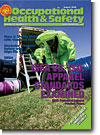
August 2006
- ISEA vs. ISO: Apparel Standards Examined
- Maximize Flaggers' Safety with Hi-Vis Gear
- Misinformation and the ANSI Standard
- Why Drugs and Safety Don't Mix
Click here to subscribe.
Features
By Dr. James P. Zeigler
IF you feel that there have been more "once in a lifetime" natural disasters in the past few years to last 10 lifetimes, you're not imagining things. The International Federation of the Red Cross and Red Crescent Societies, which publishes a World Disasters Report annually, calculates that from 1994 to 1998, reported disasters averaged 428 per year.
By Linda J. Sherrard
"IT showed something bad. . . . Come check this thing out, it showed something!" were the gasping utterances of a dirty, sweat-streaked, very excited (and obviously frightened) maintenance fellow. The multi-gas monitor, after months of use, had sounded an alarm that startled the crew while working in a tunnel.
By Jerry Laws
THERE'S been a change in the motivation of the companies that call STI Machine Services, Inc. seeking help with their machine guarding concerns. The change is that most of them haven't been stampeded into action by an OSHA citation or a crippling injury.
By Charles Roberson
FOR many industrial protective apparel end users, determining the proper protective garment to ensure worker safety is problematic. 29 CFR 1910.132, the personal protective equipment section of the OSHA General Industry Regulations, requires that employers "assess the workplace to determine if hazards are present, or are likely to be present, which necessitate the use of personal protective equipment (PPE)."
By Greg Hayward
ON June 1 way back in 1999, a new standard for high-visibility safety apparel was established by ANSI/ISEA. This methodically researched and carefully written standard provides a concise, consistent, and authoritative guide for the design, performance, and use of high-visibility garments in the workplace. (More than 65 percent of all high-visibility garments are used in the road construction segment.)
By Patricia David, MD, MSPH
EMPLOYING safe and substance-free employees, as well as maintaining a substance-free workforce, are high priorities for business owners and human resource administrators. Statistics show that implementing regulatory drug and alcohol screenings can potentially save a company hundreds of thousands of dollars in medical and accident claims.
By Peter Cholakis
IT'S a fact: 10-14 percent of the U.S. workforce abuses drugs.1 That's 10-14 percent of workers in any company, so if you think drug abuse doesn't affect your place of employment, you're probably wrong. Research also shows 65 percent of all on-the-job accidents can be linked to drug use. While these findings might surprise safety managers and CEOs, what's more surprising is that few corporations have programs in place to mitigate the problem.
By Pat Jaugstetter
USING thermal imaging cameras in addition to water from standpipes, firefighters extinguished a fire in a power-generating turbine that was protected by a sprinkler. Constructed of steel framing with concrete floors, walls, and roof deck, the building had a smoke detection system, a wet-pipe sprinkler system, and a dry-pipe standpipe system that provided full coverage.
Departments
By Eric Lesser
"DON'T trust anyone over 30" was the cultural byword of the very generation that is now approaching retirement age. The graying of Woodstock Nation, a global demographic stretching from the United States to Japan, would normally have signaled the departure of older workers and the arrival of a younger generation. The relatively small number of children born to the Baby Boomers, however, has resulted in an unprecedented phenomenon: Employers in nearly every industrialized nation are starting to think about retaining their workers ages 50 and over, either as staffers or contractors.
By Ronnie Rittenberry
THEY don't make phone booths like they used to. The clear-paneled boxes with folding doors and actual phone books on built-in shelves began disappearing from the landscape long before the rise of cellphones, but now that nearly three out of four people in this country have mobile phone service, even the traditional, unsheltered payphone itself is becoming more passé every day.
By Jerry Laws
MORE planning is needed to accommodate special needs populations in a major hurricane evacuation, according to a recent report to Congress by DOT and DHS that examined preparedness for such a mass evacuation. The full report, available at www.fhwa.dot.gov/reports/hurricanevacuation/, is much broader in scope and indicates evacuation of all coastal residents, not just disabled ones, is not yet adequately planned despite the problems encountered during 2005's hurricanes.